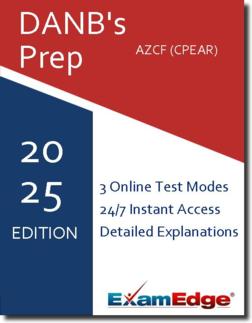DANB's AZCF (CPEAR) (AZCP) Practice Tests & Test Prep by Exam Edge - Topics
Based on 17 Reviews
- Real Exam Simulation: Timed questions and matching content build comfort for your DANB's AZCF (CPEAR) test day.
- Instant, 24/7 Access: Web-based DANB's Coronal Polish Exam for Arizona Residents practice exams with no software needed.
- Clear Explanations: Step-by-step answers and explanations for your DANB's exam to strengthen understanding.
- Boosted Confidence: Reduces anxiety and improves test-taking skills to ace your DANB's Coronal Polish Exam for Arizona Residents (AZCP).

Understanding the exact breakdown of the DANB's Coronal Polish Exam for Arizona Residents test will help you know what to expect and how to most effectively prepare. The DANB's Coronal Polish Exam for Arizona Residents has 100 multiple-choice questions The exam will be broken down into the sections below:
| DANB's Coronal Polish Exam for Arizona Residents Exam Blueprint | ||
|---|---|---|
| Domain Name | % | Number of Questions |
| Dental and oral anatomy | 8% | 8 |
| Distinguish between oral prophylaxis and coronal polish | 7% | 7 |
| Objective of coronal polish | 7% | 7 |
| Dental deposits | 15% | 15 |
| Polishing precautions | 15% | 15 |
| Patient education and recordkeeping | 10% | 10 |
| Abrasives and polishing agents | 8% | 8 |
| Polishing technique | 20% | 20 |
| Infection control/OSHA protocol | 10% | 10 |


